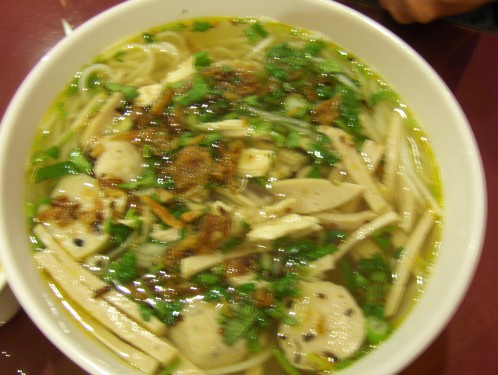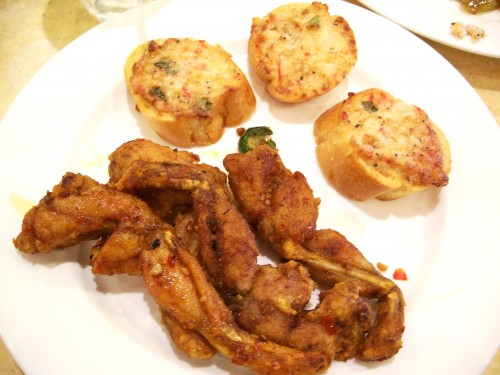
I have discovered another great soup. My fingers trembled with anticipation over the sweet aroma, the shining aurulent broth, those fragile fatty bubbles that form a thin film on the surface, the promising dapple of fried shallot,… and the pictures got all blurry. So just squint your eyes and pretend for the moment that you’re hunching over a bowl of piping hot succulence and the steam makes your eyes hazy. Can you smell that sweet aroma? No? Grab a chair at Bánh Cuốn Tây Hồ #9 in North Oakland, ask for a bowl of bún mộc, and find out for yourself.
Before diving thy chopsticks into the noodle soup, let us start with the name. It can be spelled either bún mọc or bún mộc, the hat on the “o” changes the word’s meaning and thus the name’s origin, but nobody is certain which one is correct. “Mộc” means “simple”, the broth is simply boiling water savorized by salt, pepper, nuoc mam, pork, shiitake, and wood ear mushroom. “Mộc” also means pork paste (twice-ground or pounded pork, seasoned, known as “giò sống” in Vietnamese), which is the central ingredient in the original soup but not in the rendition at Tay Ho #9. I like gio song, but sliced meatballs and cha lua (silk sausage) make a trustworthy substitution. The cook here also threw in some shredded chicken breast as a reassurance of familiar fixings. Now if you drop the hat on the “o”, “Mọc” is the nickname of the former village Nhân Mục, a part of west Hanoi today. This village can very well be the hometown of the meat-laden rice noodle soup, hence the noodle soup’s name. However the spelling goes, all we southerners know is bun moc comes from the north and is less than popular in Saigon. Most Vietnamese immigrants in the Star Flag States are southerners, so bun moc is even harder to find on the menus here. But as long as there’s a kitchen somewhere churning out these mouth-warming, bellicious bowls, there will be my pair of chopsticks eager for a hearty winter fling.
In the mood for something a little more adventurous?

